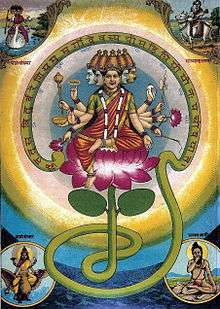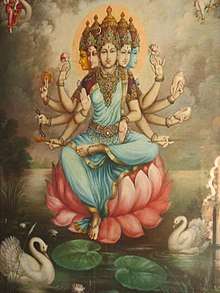Gayatri
| Gayatri | |
|---|---|
| Goddess of Vedas , education, purity, and power | |
 Illustration by Raja Ravi Verma. In illustrations, the goddess often sits on a lotus flower and appears with five heads and five pairs of hands. | |
| Affiliation | Devi, Adi Parashakti,Parvati, saraswati |
| Mantra | Gayatri Mantra |
| Mount | Lion, Nandi[1], Hamsa |
| Consort |
Sadashiva (in Shaivite view)[2] |
Gayatri (Sanskrit: गायत्री, IAST:gāyatrī) is the personified form of popular Gayatri Mantra, a hymn from Vedic texts.[3] She is also known as Savitri and Vedamata (mother of vedas). Gayatri is often associated with Savitr, a solar deity in the vedas.[4][5] Gayatri is the consort of Lord Brahma in Puranic concepts. Saivite texts identify Gayatri as the consort of Shiva, in his highest form of Sadasiva with five heads and ten hands.[6][2]
Development
Gayatri was the name initially applied to a metre of the Rig Veda consisting of 24 syllables.[7] In particular, it refers to the Gayatri Mantra and the Goddess Gāyatrī as that mantra personified. The Gayatri mantra composed in this triplet form is the most famous. Most of the scholars identifies Gayatri as the feminine form of Gayatra, other name of vedic Solar god which is also one of the synonyms of Savitri and Savitr.[8] However, the transition period of mantra turned into personification is still unknown. There are two different sources available to construct her development through ages. One is puranic texts describing her association with Saraswati and Brahma. Another source is Saivite texts identifying Gayatri, the consort of Sadasiva.[2]
Shaivite Gayatri
Saivism sees Gayatri as the consort of eternal blissful absolute Parashiva who manifests in the form of sun, Sivasurya.[9][10] He is omnipotent omnipresent Sadasiva, whose name is Bharga.[11] Sadashiva's consort Manonmani is non other than the mantra form of Gayatri which possess the power of her husband Bharga,within her.[12][13] It should be noted that the popular form of Gayatri with five heads and ten arms was initially found in Saivite iconographies of Manonmani in North India beginning from 10th century CE.[6][2] Saivite view on Gayatri seems a later development from the combination of vedic practice of Gayatri reverence and its Saivite inclusion as a manifestation of Shakti. This could be the root for the terrific aspect of Gayatri explained in the later puranas as the killer of demon Vetra identifying her with Adi Parashakti.[14]
Puranic Gayatri

Gayatri is said to be the other names of Sarasvati, the wife of Brahma.[15] According to Matsya Purana, Brahma formed from his own immaculate substance a female, who is celebrated under the names of Shatarupa, Savitri, Sarasvati, Gayatri, and Brahmani.[16] In Kurma Purana, Gautama rishi was blessed by Goddess Gayatri and able to eliminate the obstacles he faced in his life. Skanda Puran tells that Gayatri is the second wife of Brahma after Savitri, which make her distinct from Saraswati.[17] It goes Brahma married Gayatri to fulfill Brahma's vedic sacrifices as Savitri was late to attend. In this story, Gayatri is described as a beautiful milkmaid found by Indra near the holy place, Pushkar.[7]
Skanda purana continues that Savitri became angry knowing the wedding of Gayatri with Brahma and cursed all the gods and goddesses engaged in the event.[18][7] However, the Padma Purana narrates the same story with little modification. After Savitri was appeased by Brahma, Vishnu and Lakshmi, She accepts Gayatri as her sister happily.[19] Padma Purana and Skanda PUrana symbolically tell how does the personified Gayatri was included into Hindu pantheon distinct from Saraswati or Savitri.
She further developed into a fierce goddess who could even slay a demon. According to Varaha Purana and Mahabharata, Goddess Gayatri slayed the demon Vetrasura, the son of Vritra and river Vetravati, on a Navami day.[20][21]
Depiction

Earlier bronze images of Gayatri is appeared in the Himachal Pradesh, where she was revered as the consort of Sadasiva.[2] Some of these forms are terrific in nature. One of the bronze images of Gayatri dated back to 10th c. CE was obtained from Champa region and now preserved in Delhi museum. It appears with five faces and ten hands holding, sword, lotus, trident, disc, skull, Varada in left and goad, noose, a manuscript, the jar of ambrosia and Abhaya in right.[1] She resides in the mount Nandi. Modern depictions illustrates swan as her mount. Old iconography of Shaivite Manonmani Gayatri was misunderstood as the same of Brahmanic Gayatri later and Fine paintings of Gayatri appears from 18th century CE in which she is often portrayed with third eye, crescent moon and five heads with five different colors same like Sadasiva.
The well known form of Gayatri with the Saivite influence will appear having five heads (Mukta, Vidruma, Hema, Neela, Dhavala) with the ten eyes looking in eight directions plus the earth and sky, and ten arms holding various types of weapons attributed to Shiva, Vishnu and Brahma. Another recent depiction is accompanied by a white swan holding a book to portray knowledge in one hand and a cure in the other, as the Goddess of education.[22] She is even depicted four armed mounted on hansa holding weapons symbolizing tridev.vedas of bhrama, Discus of vishnu and trident of shiva and vard mudra. She also has an fearsome 3 faced depiction , 2 faces look like that of godess kali and one clam one and holding weapons like mahakali godess.She shown mounted on lotus holding lotus , noose , trident , Scimitar and vard mudra in right whereas conch , discus , bow-arrow , goad and abhay mudra in left.
Festivals - Gayatri Jayanti and Navratri
Gayatri Jayanti
It is day when Maa Adishakti took form of gayatri to kill vetrasur. It has 2 dates both are believed in different areas of India one is on Shravan Purnima and other on Shukla Paksha Ekadashi during Jyeshtha lunar month and it is usually observed on the next day of Ganga Dussehra.
Navratri
She is worshipped during Navratri as all the forms of Maa Adishakti are worshipped in those days.
See also
References
- 1 2 3 B.N. Sharma (1976). Iconography of Sadasiva. Abhinav Publications. pp. 25–29. ISBN 9788170170372.
- 1 2 3 4 5 6 Omacanda Hāṇḍā (1992). Śiva in art: a study of Śaiva iconography and miniatures. Indus Pub. House.
- ↑ Bradley, R. Hertel; Cynthia, Ann Humes (1993). Living Banaras: Hindu Religion in Cultural Context. SUNY Press. p. 286. ISBN 9780791413319.
- ↑ Constance Jones, James D. Ryan (2005), Encyclopedia of Hinduism, Infobase Publishing, p.167, entry "Gayatri Mantra"
- ↑ Roshen Dalal (2010), The Religions of India: A Concise Guide to Nine Major Faiths, Penguin Books India, p.328, entry "Savitr, god"
- 1 2 Margaret Stutley (2006). Hindu Deities: A Mythological Dictionary with Illustrations. Munshiram Manoharlal Publishers. ISBN 9788121511643.
- 1 2 3 Bansal, Sunita Pant (2005). Hindu Gods and Goddesses. Smriti Books. p. 23. ISBN 9788187967729.
- ↑ Ramachandra Rao, Saligrama Krishna (1998). R̥gveda-darśana: Gāyatri mantra. Kalpatharu Research Academy. p. 77.
- ↑ Vallyon, Imre (2012). Planetary Transformation: A Personal Guide To Embracing Planetary Change. Bookbaby. p. 245. ISBN 9780909038908.
- ↑ CHETTY, D. GOPAUL (1923). NEW LIGHT UPON INDIAN PHILOSOPHY OR SWEDENBORG AND SAIVA SIDDHANTA. p. 52.
- ↑ Frawley, David (2015). Shiva: The Lord of Yoga. Lotus Press. ISBN 9780940676299.
- ↑ Uma Devi, Mudigonda (1990). Palkuriki Somanatha: His Contribution to Sanskrit Literature. Rasagangotri. pp. 123–183.
- ↑ Sankaracharya (2000). Śrī Dakshināmūrti stotram: stava rajaṁ, astakam, samsmaranam and upanishat (stepping stone to Vedant). Sānkhyāyana Vidyā Parishat. pp. 6–7.
- ↑ Jagdish Lal Shastri, Arnold Kunst (1985). Ancient Indian Tradition & Mythology, Volume 31. Motilal Banarsidass. p. 98. ISBN 9780895817778.
- ↑ Guru Granth Sahib an Advance Study. Hemkunt Press. p. 294. ISBN 9788170103219.
- ↑ Ludvík, Catherine (2007). Sarasvatī, Riverine Goddess of Knowledge: From the. Brill. p. 119. ISBN 9789004158146.
- ↑ Kennedy, Vans (1831). Researches Into the Nature and Affinity of Ancient and Hindu Mythology by Vans Kennedy. Longman, Rees, Orme, Brown and Green,. pp. 317–324.
- ↑ Sharma, Bulbul (2010). The book of Devi. Penguin Books India. pp. 72–75. ISBN 9780143067665.
- ↑ Holdrege, Barbara A. (2012). Hindu Mythology, Vedic and Puranic. SUNY Press. ISBN 9781438406954.
- ↑ B K Chaturvedi (2017). Varaha Purana. Diamond Pocket Books Pvt Ltd. p. 108. ISBN 9788128822261.
- ↑ Bibek, Debroy (2002). The holy Puranas Volume 2 of The Holy Puranas: Markandeya, Agni, Bhavishya, Brahmavaivarta, Linga, Varaha. B.R. Pub. Corp. p. 519. ISBN 9788176462969.
- ↑ "Gayatri Mantra". Vedic Rishi. Vedicrishi Astro. Retrieved 7 February 2018.
| Wikimedia Commons has media related to Gayatri. |
